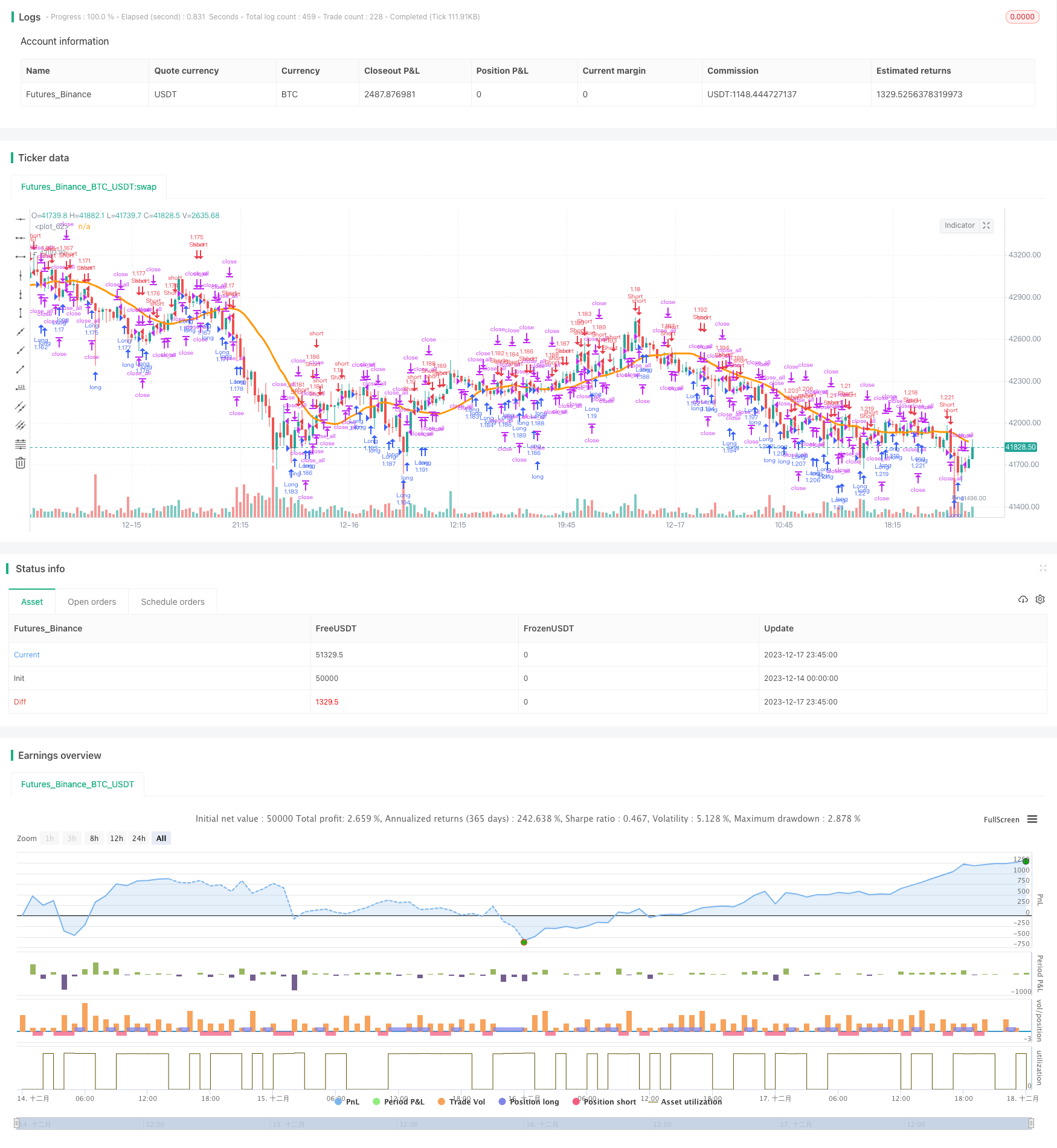
概述
Noro的快速RSI切换策略是一种利用RSI指标识别超买超卖机会的量化交易策略。该策略同时结合了K线形态、均线过滤和止损方法,以控制风险。
该策略主要基于以下几个关键组件:
- 快速RSI指标:用于识别超买超卖机会
- K线形态:结合K线实体和阴阳线,辅助判断趋势
- 均线过滤:利用SMA均线进行过滤,避免虚假信号
- 止损机制:结合RSI极限区域,实现止损
策略原理
Noro的快速RSI切换策略主要判断以下几种买卖信号:
快速RSI超买超卖信号:当快速RSI上穿其上限或下穿其下限时,产生交易信号。
K线形态信号:结合K线实体大小、阴阳线方向等,判断趋势,辅助快速RSI产生信号。
均线过滤信号:结合SMA均线方向,避免出现假突破。
止损信号:当快速RSI回穿其上限或下限时,平仓止损。
具体来说,该策略基于快速RSI的超买超卖区间来判断交易机会。当快速RSI下穿其下限,视为超卖信号;当快速RSI上穿其上限,视为超买信号。
为了避免噪音,策略加入以下辅助判断:
- K线实体大小:K线实体越大,趋势越明显
- 阴阳线:判断K线趋势方向
- SMA均线:过滤假突破信号
- 止损:快速RSI回穿限定区域时止损
所以,该策略同时结合快速RSI、K线形态、均线和止损来实现交易决策。
策略优势
该策略具有以下几点优势:
- 快速RSI灵敏度高:可以快速捕捉超买超卖机会
- K线及均线辅助判断:避免噪音交易
- 自动止损:可以及时止损,控制风险
- 适合短线交易:适用于短线周期如1小时、30分钟等
- 容易优化:可以调整参数,适应不同市场
策略风险
该策略也存在一定的风险:
- 可能出现连续止损:在震荡行情中,会出现较多止损信号
- 参数需要优化:不同周期和品种,需要调整参数
- 无法完全避免亏损:及时止损也会带来一定程度的亏损
为降低风险,可以从以下几个方面进行优化:
- 优化快速RSI参数,降低噪音交易
- 优化止损位置,控制单笔亏损
- 增加资金管理模块,分散风险
策略优化方向
该策略可以从以下几个方面进行优化:
- 增加止盈策略:在利润到达一定水平后止盈,锁定部分利润
- 增加资金管理:加入仓位控制、风险分散等管理手段
- 不同周期参数优化:调整指标参数,测试不同周期的效果
- 增加机器学习:使用算法自动优化参数,适应市场变化
- 不同品种测试:在更多品种中测试策略健壮性
通过止盈、风险管理、参数优化、机器学习等手段进一步完善该策略,能够大幅提高策略稳定性。
总结
总的来说,Noro的快速RSI切换策略结合快速RSI指标与辅助K线技术指标,实现了一个对超买超卖进行判断的短线交易策略。该策略响应敏捷、易优化,同时加入了止损模块来控制风险。通过进一步的机器学习及参数优化,有望获得更好的策略效果。
策略源码
/*backtest
start: 2023-12-14 00:00:00
end: 2023-12-18 00:00:00
period: 15m
basePeriod: 5m
exchanges: [{"eid":"Futures_Binance","currency":"BTC_USDT"}]
*/
//Noro
//2018
//@version=2
strategy(title = "Noro's Fast RSI Strategy v1.7", shorttitle = "Fast RSI str 1.7", overlay = true)
//Settings
needlong = input(true, defval = true, title = "Long")
needshort = input(true, defval = true, title = "Short")
usemar = input(false, defval = false, title = "Use Martingale")
capital = input(100, defval = 100, minval = 1, maxval = 10000, title = "Capital, %")
usersi = input(true, defval = true, title = "Use Fast RSI Strategy")
usemm = input(true, defval = true, title = "Use Min/Max Strategy")
usebc = input(true, defval = true, title = "Use BarColor Strategy")
usesma = input(false, defval = false, title = "Use SMA Filter")
smaperiod = input(20, defval = 20, minval = 2, maxval = 1000, title = "SMA Filter Period")
fast = input(7, defval = 7, minval = 2, maxval = 50, title = "Fast RSI Period")
limit = input(30, defval = 30, minval = 1, maxval = 100, title = "RSI limit")
rsisrc = input(close, defval = close, title = "RSI Price")
rsibars = input(1, defval = 1, minval = 1, maxval = 20, title = "RSI Bars")
mmbars = input(1, defval = 1, minval = 1, maxval = 5, title = "Min/Max Bars")
showsma = input(false, defval = false, title = "Show SMA Filter")
showarr = input(false, defval = false, title = "Show Arrows")
fromyear = input(2018, defval = 2018, minval = 1900, maxval = 2100, title = "From Year")
toyear = input(2100, defval = 2100, minval = 1900, maxval = 2100, title = "To Year")
frommonth = input(01, defval = 01, minval = 01, maxval = 12, title = "From Month")
tomonth = input(12, defval = 12, minval = 01, maxval = 12, title = "To Month")
fromday = input(01, defval = 01, minval = 01, maxval = 31, title = "From day")
today = input(31, defval = 31, minval = 01, maxval = 31, title = "To day")
//Fast RSI
fastup = rma(max(change(rsisrc), 0), fast)
fastdown = rma(-min(change(rsisrc), 0), fast)
fastrsi = fastdown == 0 ? 100 : fastup == 0 ? 0 : 100 - (100 / (1 + fastup / fastdown))
//Limits
bar = close > open ? 1 : close < open ? -1 : 0
uplimit = 100 - limit
dnlimit = limit
//RSI Bars
upsignal = fastrsi > uplimit ? 1 : 0
dnsignal = fastrsi < dnlimit ? 1 : 0
uprsi = sma(upsignal, rsibars) == 1
dnrsi = sma(dnsignal, rsibars) == 1
//Body
body = abs(close - open)
abody = sma(body, 10)
//MinMax Bars
min = min(close, open)
max = max(close, open)
minsignal = min < min[1] and bar == -1 and bar[1] == -1 ? 1 : 0
maxsignal = max > max[1] and bar == 1 and bar[1] == 1 ? 1 : 0
mins = sma(minsignal, mmbars) == 1
maxs = sma(maxsignal, mmbars) == 1
//SMA Filter
sma = sma(close, smaperiod)
colorsma = showsma ? blue : na
plot(sma, color = colorsma, linewidth = 3)
//Signals
up1 = bar == -1 and (strategy.position_size == 0 or close < strategy.position_avg_price) and dnrsi and body > abody / 5 and usersi
dn1 = bar == 1 and (strategy.position_size == 0 or close > strategy.position_avg_price) and uprsi and body > abody / 5 and usersi
up2 = mins and (close > sma or usesma == false) and fastrsi < 70 and usemm
dn2 = maxs and (close < sma or usesma == false) and fastrsi > 30 and usemm
up3 = sma(bar, 2) == -1 and usebc
dn3 = sma(bar, 2) == 1 and usebc
exit = (((strategy.position_size > 0 and fastrsi > dnlimit and bar == 1) or (strategy.position_size < 0 and fastrsi < uplimit and bar == -1)) and body > abody / 2)
//Arrows
col = exit ? black : up1 or dn1 ? blue : up2 or dn2 ? red : na
needup = up1 or up2
needdn = dn1 or dn2
needexitup = exit and strategy.position_size < 0
needexitdn = exit and strategy.position_size > 0
plotarrow(showarr and needup ? 1 : na, colorup = blue, colordown = blue, transp = 0)
plotarrow(showarr and needdn ? -1 : na, colorup = blue, colordown = blue, transp = 0)
plotarrow(showarr and needexitup ? 1 : na, colorup = black, colordown = black, transp = 0)
plotarrow(showarr and needexitdn ? -1 : na, colorup = black, colordown = black, transp = 0)
//Trading
profit = exit ? ((strategy.position_size > 0 and close > strategy.position_avg_price) or (strategy.position_size < 0 and close < strategy.position_avg_price)) ? 1 : -1 : profit[1]
mult = usemar ? exit ? profit == -1 ? mult[1] * 2 : 1 : mult[1] : 1
lot = strategy.position_size == 0 ? strategy.equity / close * capital / 100 * mult : lot[1]
if up1 or up2 or up3
if strategy.position_size < 0
strategy.close_all()
strategy.entry("Long", strategy.long, needlong == false ? 0 : lot)
if dn1 or dn2 or dn3
if strategy.position_size > 0
strategy.close_all()
strategy.entry("Short", strategy.short, needshort == false ? 0 : lot)
if time > timestamp(toyear, tomonth, today, 23, 59) or exit
strategy.close_all()